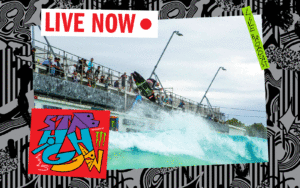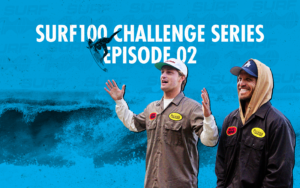The Stab Interview: Brian Bielmann
After 40 years behind the lens, Brian Bielmann’s captured some of surfing’s most iconic images, and he ain’t done yet.
For more than 40 years now, Brian Bielmann as dedicated himself to not just shooting surf photos, but capturing the essence of what it means to be a surfer. An East Coaster by upbringing, he’s spent most of his adult life on the North Shore.
After a trip over the falls at Rocky Point put a hole in his skull when he was a teenager, he picked up the camera and never looked back. The late Surfing Magazine photo editor Larry “Flame” Moore gave him his start. In the roaring ’80s he was in hog heaven shooting Pipeline by winter and Hollywood swimsuit models by summer. In the early 2000s he was Andy and Bruce Irons’ go-to photog. In other words, he’s been there, done that.
And while the surf photography game has certainly changed, Brian’s never lost his love for photography or his sense of humor about surfing. A hardcore music fan and record collector, these days Brian’s looking for his next act. Stab recently caught up with him to see what he has cooking:
Stab: Where does the Brian Bielmann story begin?
Brian: I fell in love with surfing when I was living in Virginia and surfing in Cape Hatteras and that zone. That was how it all started for me. I think that would have been about 1970. I surfed there from about ’70 to ’75 then came to Hawaii.
What were the Outer Banks like back then?
It was so fun.
We’d drive down on weekends and sometimes, during winter, you wouldn’t even see another surfer. The summer was a different story, there were guys there from all different places. I lived and worked there in ’74 and ’75. I worked at a place called Jiminy Cricket’s, it was a sub shop. I saved $200 from working all summer, then drove across the country in three days, jumped on a plane, went to Hawaii and never came back. They gave me a beer on the plane and then I just passed about. When I woke up I was in Hawaii and it was like that scene in the “Wizard Of Oz” where everything on Dorothy’s farm is black and white, then she lands in Oz and it turns into this vibrant technicolor. That’s how it felt—palms trees, and blue sky, and the white sand at Log Cabins—I knew at that moment I was never going home.
What made you want to go to Hawaii?
My brother had moved there about three years before me, so I felt like I had an in. There were about five of us at my high school that surfed, and to go to Hawaii was our dream. I went first, the rest of them joined me for the winter, and then they all went home. They said they were going to work and save money and come back. None of them came back. They all got jobs, then years later tell me how lucky I am. And I’m like, fuck, you went back. I didn’t go back.
So, how’d you get into photography?
Let’s see, I got there in ’75 and by ’78 I started having those little panic attacks, worrying about what I was actually going to do for a living. I had a month of anxiety. Then one day I decided, hey, I’ll be a surf photographer. So, I went around telling everyone I was going to be a surf photographer. I didn’t bother to go out and get equipment for a year, but I knew that’s what I was going to do.
Then after I got the equipment, I was super insecure. I didn’t want to go down to the beach when the other photographers were there because I didn’t know what I was doing. I’d wait until they left, then I’d go down there. Plus, I couldn’t stop surfing. I was surfing all the time.
What happened was that I caught this incredible wave at Pipeline at the end of the season, and I was like, that’s it, I’m going to surf Pipe every time it’s good. I’m going to become a Pipe surfer. Then the next year came, before Pipe even broke, I pulled into a barrel at Rocky Point and ended up getting sucked up and over the falls. I thought I was going to land on my feet but ended up going head-first into the reef. Big, old hole in my head. I was able to put my whole thumb in my head.
So, they rushed me to the hospital in Kahuku and stitched me up. But back then they were like Neanderthal doctors and they didn’t clean the coral out of my head. They just stitched it up. So, within three days I was taking so many pills I was hallucinating. Then one day I was doing a slide show, we all smoked joints and everything, then turned out the lights. About two hours later, we turned the lights back on and my whole forehead as swollen up. I remember a girl looking at me and screaming.
I went and looked in the mirror, and what was happening was the cut had infected my whole head, but it was covered up by my hair. It finally got to my forehead and I looked like frickin’ Herman Munster or something. They rushed me to the hospital, cut the stitches open and then drained all the puss out. I woke up in the morning and couldn’t even open eyes because my whole face was so swollen. But within three days—and I think it’s because I had a girlfriend coming over—all the infection went away.
After that I had to go home and stick a four-foot piece of gauze in my head three times a day to suck up all the puss. How gnarly is that, man?
It took about a month, and during that month I started shooting with my Century lens and camera—minus a motor drive because I didn’t have enough money for one. But that month of being out of the water is where it all started.
How did you get your first shot published?
It took a couple of years. The first quarter-page photo I ever got printed was the most unbelievable thing I’ve ever experienced. The high of seeing my quarter-page photo that I made $25 for with my photo credit on it, it sent me over the moon, dude. I was hooked. I was surf photographer—Surfing Magazine…Flame.
I remember thinking that if I could just get a quarter-page every month, that’d be half of my rent right there—my rent was $50 a month back then.
The big change came in 1987 when I had a sequence of Waimea Shorebreak that Surfing ran as a three-page double spread. That’s when I really realized that surfing’s not just about a guy on a board. There are waves, there’s lifestyle, there’s all kinds of things. And that sent me on a path of looking outside of the box. This woke me up to the fact that there’s way more to it than just the action. That was the beginning of taking it really serious and think a little bit.
And how did you learn to use all the gear?
I was mostly self-taught, until I did something wrong and somebody would help me out. I remember I ordered my first water house in the mail. There was a crew at Sunset shooting the movie “Big Wednesday.” George Greenough was down there putting his rig together, and I was so excited to introduce myself and tell him it was my first water housing.
George goes, “Well come on, let’s go! Let’s get out there!”
He was such a nice guy and I was so stoked. I jumped in the water and started paddling with him, thinking I was the real deal. Then I looked down and the housing was gushing with water inside of it. I didn’t even have the O-ring on it. That’s how dumb I was. The thing leaked so fast. I ruined my first camera that way.
Kooking out with a water housing in front of George Greenough, doesn’t get much better than that. But, basically, we’re all kooks doing our damnedest to hide it.
Yeah, man, and the reality is that about 98-percent of the surfing population are kooks. Two percent of the surfers are the heroes that we look up to and like to think that we’re in that category, but the fact is, about 98-percent of us are kooks. I’ve come to terms that, I’m okay with it.
Were you always set on shooting surf or were their other veins of photography you wanted to get into?
In 1981, I decided wanted to learn more about photography and I met some girl from L.A. I ended up moving to L.A. for the next 10 years. For all of the ‘80s I would live in Hawaii in the fall and winter, then I’d go to California in the spring and summer. I didn’t shoot much in California. I assisted photographers in the fashion industry and other advertising sort of things.
One thing I did get to do was shoot a ton of swimsuit girls for the modeling agencies. I even had my 15 minutes of fame where there was a moment in Hollywood where I was the swimsuit guy. I was 25 years old getting to shoot all the girls from the modeling agencies, I mean, come on. It was frickin’ fun, dude…in the height of the ‘80s. Surfing Mag was running a ton of swimsuit stuff and it was all my stuff.
And I was also shooting a ton of bodyboarding. Me and Tom Boyle were like the two main bodyboarding guys in the U.S. And it was super fun. It’s so funny because Hank was another one that shot a ton of bodyboarding, but he won’t admit it now. Man, it was one of the most fun times of my life.
How’d you end up back in Hawaii?
I met my first wife, no surprise, she was a swimsuit model, and we moved back to Hawaii full-time. That’s when I started traveling more and doing trips.
You were one of the main guys to travel with Bruce and Andy Irons. How’d that come about?
Zeldo, Chris Cote and Steve Sherman hired me at Transworld, and that’s really when I started traveling more. I think Transworld was the peak of my career. It was from about 2000 until Transworld went under. I was just in the zone at that time. I was everywhere I was supposed to be.
There’s a lot of great surf photographers out there, but really, what makes a surf photographer successful is having those relationships with the surfers and having them want you to go on the trips with them.
There’s a lot of weird surf photographers out there, but I guess I was just the kind of weird that people didn’t mind having around. That era, I’d say all my favorite photos are Andy and Bruce and Nathan.
Those were good days for surfing. There was cash in the industry, Andy was ruling, the mags were thick. It’s not like that today.
I talked to Lyndie [Irons] the other day on the phone, and I said to her, ‘Isn’t it the weirdest thing that when Andy passed away everything changed.’ And I used to think that it just changed for us, those that loved him and knew him, but I think it’s bigger than that. It was the end of this really fun era.
For sure. It really felt like it then, and still feels like that today. Andy’s gone. The mags are gone. Instagram killed surf photography as a viable career path. What’s your plan now after this crazy ride?
Well, that’s a great question. I’ve moved back to California, but it’s rough, man. The game has changed so much. I’m too old to get into the social media thing. I can’t imagine doing that. It doesn’t appeal to me.
What I’d like to do is work on some bigger projects. I’d like to do a book. I wouldn’t mind doing more slideshows and public speaking kinds of things. I’ve got this amazing archive that I’ve built up over 40 years of shooting, and I guess I just have to be creative about how I can use it and what’s possible with it. And, of course, I’ll keep shooting.














Comments
Comments are a Stab Premium feature. Gotta join to talk shop.
Already a member? Sign In
Want to join? Sign Up